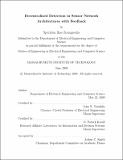Decentralized detection in sensor network architectures with feedback
Author(s)
Zoumpoulis, Spyridon Ilias
DownloadFull printable version (605.3Kb)
Other Contributors
Massachusetts Institute of Technology. Dept. of Electrical Engineering and Computer Science.
Advisor
John N. Tsitsiklis and O. Patrick Kreidl.
Terms of use
Metadata
Show full item recordAbstract
We investigate a decentralized detection problem in which a set of sensors transmit a summary of their observations to a fusion center, which then decides which one of two hypotheses is true. The focus is on determining the value of feedback in improving performance in the regime of asymptotically many sensors. We formulate the decentralized detection problem for different network configurations of interest under both the Neyman-Pearson and the Bayesian criteria. In a configuration with feedback, the fusion center would make a preliminary decision which it would pass on back to the local sensors; a related configuration, the daisy chain, is introduced: the first fusion center passes the information from a first set of sensors on to a second set of sensors and a second fusion center. Under the Neyman-Pearson criterion, we provide both an empirical study and theoretical results. The empirical study assumes scalar linear Gaussian binary sensors and analyzes asymptotic performance as the signal-to-noise ratio of the measurements grows higher, to show that the value of feeding the preliminary decision back to decision makers is asymptotically negligible. This motivates two theoretical results: first, in the asymptotic regime (as the number of sensors tends to infinity), the performance of the "daisy chain" matches the performance of a parallel configuration with twice as many sensors as the classical scheme; second, it is optimal (in terms of the exponent of the error probability) to constrain all decision rules at the first and second stage of the "daisy chain" to be equal. (cont.) Under the Bayesian criterion, three analytical results are shown. First, it is asymptotically optimal to have all sensors of a parallel configuration use the same decision rule under exponentially skewed priors. Second, again in the asymptotic regime, the decision rules at the second stage of the "daisy chain" can be equal without loss of optimality. Finally, the same result is proven for the first stage.
Description
Thesis (M. Eng.)--Massachusetts Institute of Technology, Dept. of Electrical Engineering and Computer Science, 2009. This electronic version was submitted by the student author. The certified thesis is available in the Institute Archives and Special Collections. Cataloged from student-submitted PDF version of thesis. Includes bibliographical references (p. 73-74).
Date issued
2009Department
Massachusetts Institute of Technology. Department of Electrical Engineering and Computer SciencePublisher
Massachusetts Institute of Technology
Keywords
Electrical Engineering and Computer Science.